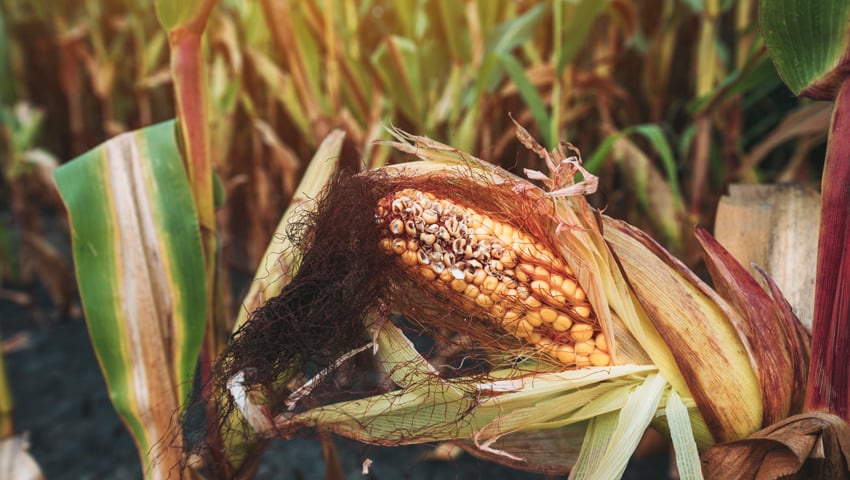More political and public awareness of the plight of the world’s crops when it comes to fungal disease is crucial to stave off a major threat to global food security.
1.5 million people die each year from fungal diseases, and in 2022, the World Health Organization (WHO) published its first list of fungal pathogens that infect humans. They warned that certain increasingly abundant disease-causing fungal strains have acquired resistance to known antifungals. Yet fungi pose another major threat to human health.
Writing in Nature, Eva Stukenbrock and Sarah Gurr report that hundreds of fungal diseases affect the 168 crops listed as important in human nutrition by the Food and Agricultural Organization (FAO) of the United Nations. Despite widespread spraying of fungicides and the planting of cultivars bred to be more disease resilient, growers worldwide lose between 10% and 23% of their crops to fungal disease every year, and another 10–20% post-harvest.
The five most important calorie crops: rice, wheat, maize (corn), soya beans and potatoes can be affected by rice blast fungus, wheat stem rust, corn smut, soybean rust and potato late blight disease (caused by a water mould oomycete), respectively.
Losses from these fungi equate to enough food to provide some 600 – 4,000 million people with 2,000 calories every day for one year. Such losses are likely to increase in a warming world.
Current problems have arisen because the adaptability of fungi has met modern agricultural practices.
Most monocultures entail vast areas of genetically uniform crops. (The world’s largest monoculture is a field of more than 14,000 hectares of genetically uniform wheat in Canada.) These provide ideal feeding and breeding grounds for such a prolific and fast-evolving group of organisms.
Better protecting the world’s crops from fungal disease will, they say, require a much more unified approach than has been achieved so far — with closer collaboration between farmers, the agricultural industry, plant breeders, plant-disease biologists, governments and policymakers, even philanthropic funders.
They say that several approaches are already being developed or used to limit disease impacts and protect crop yields.
Discovery and development of antifungals – The development of fungicides has been largely orchestrated in the agrochemical crop-protection industry. However, it is time to move away from reliance on single-target-site fungicides, and to search for compounds that target multiple processes in the pathogen.
Increasing diversity in agricultural fields – Planting seed mixtures that combine several crop cultivars carrying different resistance genes could provide an important way to slow down pathogen evolution. In 2022, around 25% of the total wheat production in Denmark used mixed cultivars, selected because they grow at a similar pace and carry complementary disease-resistance genes. This provided promising results in terms of reducing the severity of both Septoria tritici blotch and yellow and brown rust. Indeed, these cultivars could reduce the spread of disease and the erosion of crop-resistance genes.
Early disease detection and surveillance – Artificial intelligence (AI), satellites, remote- sensing tools (such as drones), incentives to persuade farmers to report disease and community-science projects that engage the public in the reporting of plant diseases (both in crops and in wild species) are beginning to engender more effective surveillance of fungal disease.
Exploiting biologics and crop biotics – Biologics are a broad category of products derived from living organisms. Just as interest in probiotics in medicine has grown over the past decade, so too has interest in the use of biologics in crop protection.
RNA (ribonucleic acid) trafficking between plants and fungi – In 2013, a research team showed that small RNAs (sRNAs) from the grey mould fungus Botrytis cinerea can silence plant host genes involved in immunity. Some of the researchers then showed that double stranded RNAs (dsRNAs) and sRNAs from the fungus could protect vegetables and fruit against grey mould disease for up to ten days. However, RNAs (usually encapsulated in tiny vesicles) are not only transferred from the fungus to the host — plant hosts also dispatch vesicles to suppress fungal virulence genes.
The researchers also say that a global body for plant health is needed.
Between January 2020 and January 2023, the UK Research and Innovation (UKRI) council allocated around US$686 million to COVID-19 research, and almost 225,000 papers on COVID-19 were published globally.
They say, given that food security engenders health and well-being, agriculture and farmers are arguably just as crucial to human health as medicine and health-care providers.
Addressing the threat to human health posed by fungal crop diseases will require greater engagement with the problem, and more investment in research from governments, philanthropic organizations and private companies.
